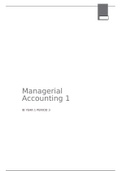Summary
Summary Managerial Accounting 1 (MAC)
- Course
- Institution
- Book
This is a summary for the course Managerial Accounting 1. It refers to the Chapters 16, 17, 19, 20, 22, 24, and 25 of the book "Horngren's Financial and Managerial Accounting: the Managerial Chapters".
[Show more]




